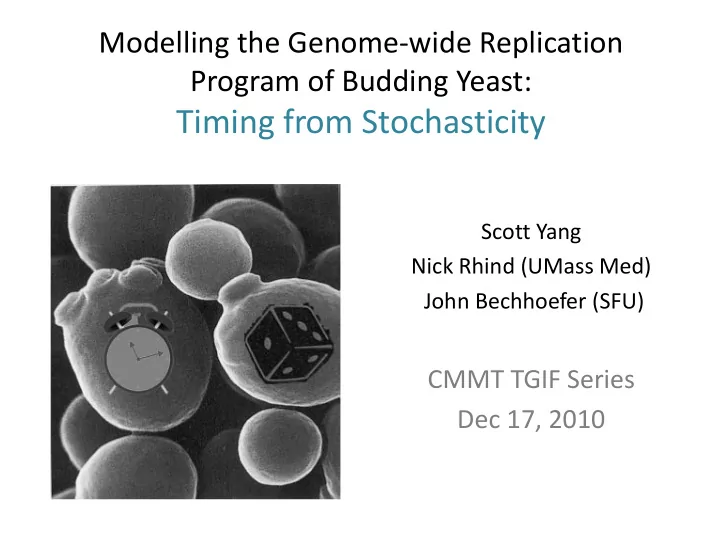

Modelling the Genome-wide Replication Program of Budding Yeast: Timing from Stochasticity Scott Yang Nick Rhind (UMass Med) John Bechhoefer (SFU) CMMT TGIF Series Dec 17, 2010
Take-home messages • Should consider DNA replication from a stochastic point of view • Precise timing of the replication program can emerge from stochasticity
DNA replication http://www.paterson.man.ac.uk/cellcycle/replication.stm
DNA replication: the Kinetics S phase S Non-replicated G1 Potential origins
DNA replication: the Kinetics S phase S Non-replicated G1 Potential origins Origins + forks = replication program
A Microarray Experiment synchronize Raghuraman et al . Science 2001
Replication profiles Position x 100 % replication 0 Time (min) Raghuraman et al . Science 2001
Replication profiles Replication time profile VI Raghuraman et al . Science 2001
Replication profiles Position x Position x 100 100 % replication % replication 0 0 Time (min) Time (min) Raghuraman et al . Science 2001
Replication profiles Replication time profile Replication fraction profile 100 VI % Replication 0 Raghuraman et al . Science 2001 McCune et al. Genetics 2008
Point of Views More deterministic • Each origin has a preprogrammed firing time • plus some variation around that time
Point of Views More deterministic More stochastic • Each origin has a • Each origin has a distribution of firing times preprogrammed firing time • has an expected firing • plus some variation around time that time
Point of Views More deterministic More stochastic • Each origin has a • Each origin has a distribution of firing times preprogrammed firing time • has an expected firing • plus some variation around time that time • How to ensure precise firing • What counts the time and time if needed? how?
Parametric model Firing-time distribution 0 100 200 Genome position (kb) x: origin position Cumulative firing-time distribution t 1/2 : median of distribution = sigmoid function t w : width of distribution v: globally constant fork velocity
Parametric model Firing-time distribution 0 100 200 Genome position (kb) 100 x: origin position % rep. t 1/2 : median of distribution t w : width of distribution 0 v: globally constant fork velocity
Key theoretical idea N x x i f ( x , t ) 1 1 t i v i 1 global fork velocity
Result 1: fit McCune 2008
Result 1: fit McCune 2008
Result 2: firing-time distributions
An idea Maybe…origins The number of MCM with wi th lot lots s of of exceeds the number MC MCM f M fire re of ORC by a factor of ear arly. y. 10 – 100 in various organisms! Nick Hyrien 2003
Multiple stochastic initiators Firing-time dist. Time (min)
Multiple initiator model Increasing # of initiators
Point of Views More stochastic • How to ensure precise firing time if needed?
Point of Views More stochastic • How to ensure precise firing time if needed? • Give it lots of MCM
Point of Views More deterministic More stochastic • How to ensure precise firing • What counts the time and time if needed? how? • Give it lots of MCM
Point of Views More deterministic More stochastic • How to ensure precise firing • What counts the time and time if needed? how? • Give it lots of MCM • ????
Conclusions • DNA replication is a stochastic process • We have developed a flexible, analytical model • Timing needs not be from an explicit clock (contrary to most biologists’ intuitions?) • Timing can emerge from multiple stochastic initiators (MCM2 – 7) Yang, Rhind, Bechhoefer, MSB 2010
Current work • Probe MCM occupancy and other factors • Other experimental setups & techniques • Other organisms universal program? Molecular Systems Biology 6 :404 (2010) Thank you!
Toy replication fraction profile A culture of cells T minutes into S phase 1 origin Average 100 % rep + + + + … 0 position Firing-time distribution
Recommend
More recommend